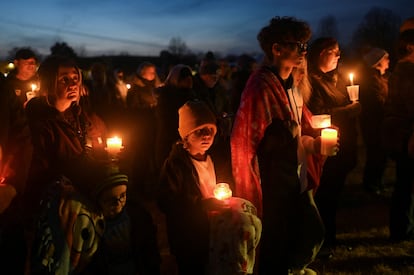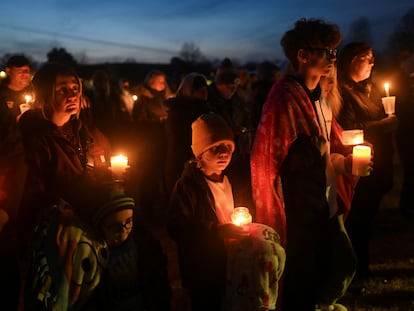Iowa promised $75 million for school safety. Two shootings later, the money is largely unspent
Citing an urgent need to act after Uvalde and shootings outside a high school and a church in Iowa, Gov. Kim Reynolds said the state would award up to $50,000 each to 1,500 schools to fix vulnerabilities

The June 2022 announcement was addressed to parents horrified by the massacre at an elementary school in Uvalde, Texas: Iowa would spend $75 million in federal pandemic relief funds to improve school building security.
Citing an urgent need to act after Uvalde and shootings outside a high school and a church in Iowa, Gov. Kim Reynolds said the state would award up to $50,000 each to 1,500 schools to fix vulnerabilities. Like many other Republicans, she rebuffed calls for stricter gun control while embracing efforts to “harden” schools.
More than 19 months and two deadly Iowa school shootings later, the money only recently started to trickle out, with the vast majority still unspent in part due to bureaucratic delays by local and state officials, according to records reviewed by The Associated Press. Contractors helping run the program, meanwhile, have received millions.
The AP found that most schools statewide have yet to receive funding, including those in Perry, a city of 8,000 people where a Jan. 4 school shooting left two dead and several injured. A state agency last week sent a representative to help Perry district officials finish their application for a $150,000 grant through Reynolds’ program, a process they started more than a year ago.
“After the tragedy in Perry, we are continuing to look for opportunities to make the process more efficient and effective,” said Allie Bright, spokesperson for the Iowa Department of Homeland Security and Emergency Management, which oversees the program.
Perry’s $150,000 is among $20.6 million the state has awarded for upgrades at hundreds of school buildings across Iowa, but payments for completed work have been far less to date. State spending data updated this month shows the program had sent $855,000 to 16 districts and schools that are mostly small and rural.
The district in Gilbert received the most, $194,000, which went toward surveillance cameras, new entry systems and door controls. Winfield Mount Union Community School District, which recently announced it will cut back to a four-day school week in the next academic year, added cameras and panic buttons with its $100,000.
Other eligible expenses include metal detectors, locks, alarms and notification systems, security lighting, reinforced doors and windows, barriers and fencing.
Perry officials expressed interest in the grant in 2022 and completed assessments on buildings as required a year ago. But the application was not finished before the Perry High School shooting.
It’s unknown whether additional security could have prevented 17-year-old Dylan Butler from opening fire in the cafeteria before classes began. Investigators haven’t revealed how Butler obtained the shotgun and handgun he used. Perry’s superintendent has credited an assistant principal with activating an emergency alert that resulted with a quick response by police, who found Butler dead.
Perry elementary and middle school students who returned to school this week saw tighter security, including uniformed officers and limited entry points. Some parents have called for additional measures such as metal detectors, and district officials are considering how to spend the grant money.
Similar concerns were raised after the January 2023 shooting at Starts Right Here, a Des Moines alternative school for at-risk youth. Preston Walls was sentenced last week to 65 years in prison for killing fellow students 18-year-old Gionni Dameron and 16-year-old Rashad Carr.
Relatives of Dameron and Carr are suing the school, alleging inadequate security. That school, like others affiliated with the Des Moines district, the state’s largest, has yet to be awarded grant funding.
Des Moines schools spokesman Phil Roeder said the district needs to update a purchasing policy to meet federal requirements to receive the roughly $3 million it requested. The school board is expected to do that in February.
Iowa authorities have reported a surge in school threats since the Perry shooting, which killed sixth grader Ahmir Jolliff and principal Dan Marburger and injured several others. Threats in West Des Moines, Davenport and Lenox led to criminal charges, and another briefly shut down the St. Ansgar district. Thirteen districts were targeted last week by “swatting” calls, in which someone makes a prank call to emergency services to prompt a response at a particular address.
Against a drumbeat of threats and shootings, security funding is popular with lawmakers and parents, even as researchers debate whether the measures reduce gun violence.
Iowa’s 327 districts and 183 nonpublic and independent schools still have until until Oct. 1 to apply, and most have started that process, Bright said. Once approved, they have through 2024 to designate money for projects and 2025 to get work completed and seek reimbursement. The maximum per building is $50,000 regardless of enrollment.
The money is coming from Iowa’s share of the American Rescue Plan Act signed by President Joe Biden nearly three years ago, which was designed to help states recover from the coronavirus pandemic. That funding source is appropriate, Iowa officials say, because violent crime and school safety concerns increased during the pandemic.
Reynolds said she did not believe any law could have prevented the Perry shooting, and spokesperson Kollin Crompton said Reynolds is proud of the state’s work to improve school safety. He noted that Iowa has purchased 1,200 emergency radios for schools, started a tip line where threats can be anonymously reported, and provided thousands with active shooter training.
Several states have similar school safety programs but few use American Rescue Plan Act funding. Two that have, Ohio and New Hampshire, awarded grants in 2022.
Consultants and vendors have received most of Iowa’s spending so far, including $5.2 million to Tetra Tech, an engineering business that conducted 1,260 building assessments to identify weaknesses that projects would fix.
The state has paid $1.6 million to AG Witt, a company helping run the program with Iowa’s Homeland Security Department. The agency said it was too small to handle the workload.
“It is a federal grant, so of course there’s obviously a lot of little headaches that go with it,” department director John Benson told applicants last year.
Some assessments emailed by Tetra Tech were lost in the spam folders of school administrators or faced several weeks or months of delays getting the state’s review and approval. A state official apologized to school officials during a meeting last year for that backlog.
Another requirement is slowing down projects: Physical changes to schools must be approved for compliance with Iowa’s fire code. That is taking three months or longer for buildings inspected by the state fire marshal’s office, which was recently moved to a new department.
One student who fled jazz band rehearsal when gunshots rang out at Perry said she will feel safe going back when high school resumes next week.
“The threat to our school was gone the day of the shooting,” Rachael Kares said.
Sign up for our weekly newsletter to get more English-language news coverage from EL PAÍS USA Edition
Tu suscripción se está usando en otro dispositivo
¿Quieres añadir otro usuario a tu suscripción?
Si continúas leyendo en este dispositivo, no se podrá leer en el otro.
FlechaTu suscripción se está usando en otro dispositivo y solo puedes acceder a EL PAÍS desde un dispositivo a la vez.
Si quieres compartir tu cuenta, cambia tu suscripción a la modalidad Premium, así podrás añadir otro usuario. Cada uno accederá con su propia cuenta de email, lo que os permitirá personalizar vuestra experiencia en EL PAÍS.
¿Tienes una suscripción de empresa? Accede aquí para contratar más cuentas.
En el caso de no saber quién está usando tu cuenta, te recomendamos cambiar tu contraseña aquí.
Si decides continuar compartiendo tu cuenta, este mensaje se mostrará en tu dispositivo y en el de la otra persona que está usando tu cuenta de forma indefinida, afectando a tu experiencia de lectura. Puedes consultar aquí los términos y condiciones de la suscripción digital.
More information
Archived In
Últimas noticias
Most viewed
- Sinaloa Cartel war is taking its toll on Los Chapitos
- Oona Chaplin: ‘I told James Cameron that I was living in a treehouse and starting a permaculture project with a friend’
- Reinhard Genzel, Nobel laureate in physics: ‘One-minute videos will never give you the truth’
- Why the price of coffee has skyrocketed: from Brazilian plantations to specialty coffee houses
- Silver prices are going crazy: This is what’s fueling the rally










































